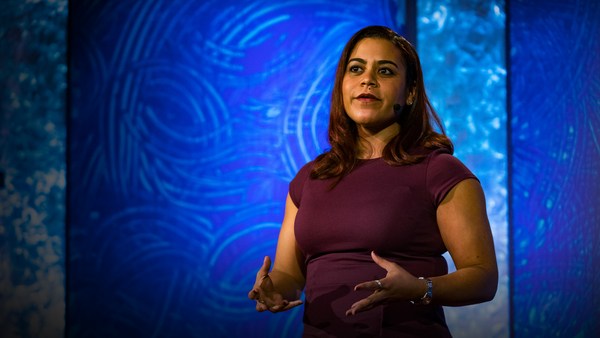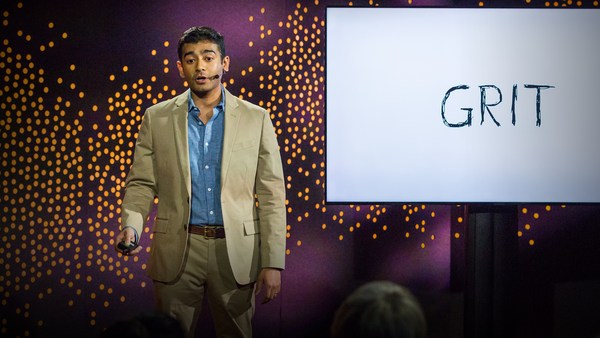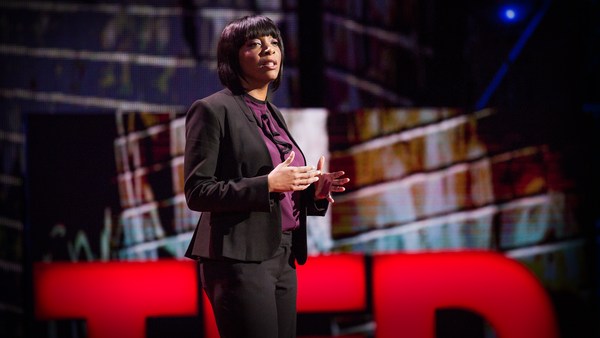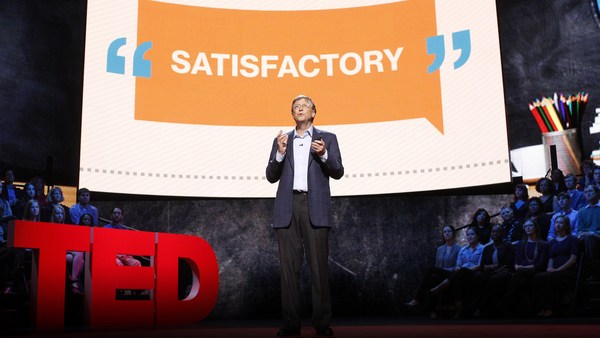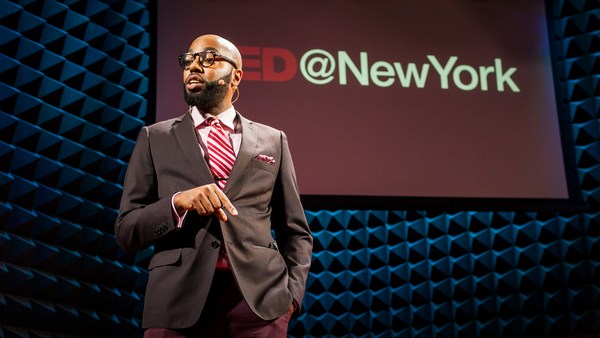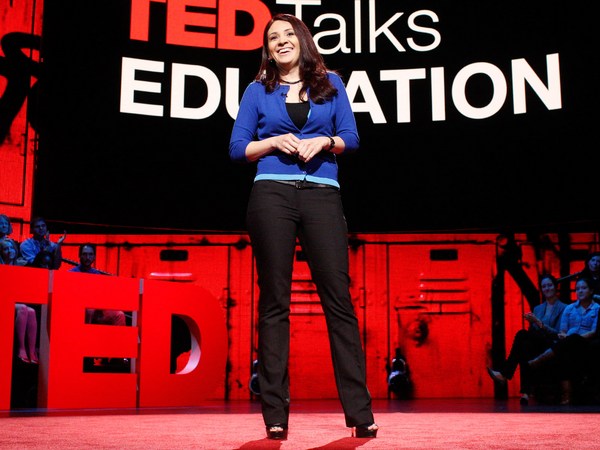Like many teachers, every year on the first day of school, I lead a sort of icebreaker activity with my students. I teach at Lincoln High School in Lincoln, Nebraska, and we are one of the oldest and most diverse high schools in our state. Also, to our knowledge, we're the only high school in the world whose mascot is the Links. Like, a chain.
(Laughter)
And with that being our mascot, we have a statue out front of our building of four links connected like a chain. And each link means something. Our links stand for tradition, excellence, unity and diversity.
So on the first day of school, I teach my new ninth-graders about the meaning behind those links, and I give them each a slip of paper. On that paper, I ask them to write something about themselves. It can be something that they love, something that they hope for -- anything that describes their identity. And then I go around the room with a stapler, and I staple each of those slips together to make a chain. And we hang that chain up in our classroom as a decoration, sure, but also as a reminder that we are all connected. We are all links.
So what happens when one of those links feels weak? And what happens when that weakness is in the person holding the stapler? The person who's supposed to make those connections. The teacher.
As teachers, we work every day to provide support socially, emotionally and academically to our students who come to us with diverse and tough circumstances. Like most teachers, I have students who go home every day, and they sit around the kitchen table while one or both parents makes a healthy, well-rounded meal for them. They spend suppertime summarizing the story they read in ninth-grade English that day, or explaining how Newton's laws of motion work. But I also have students who go to the homeless shelter or to the group home. They go to the car that their family is sleeping in right now. They come to school with trauma, and when I go home every day, that goes home with me.
And see, that's the hard part about teaching. It's not the grading, the lesson-planning, the meetings, though sure, those things do occupy a great deal of teachers' time and energy. The tough part about teaching is all the things you can't control for your kids, all the things you can't change for them once they walk out your door. And so I wonder if it's always been this way.
I think back to my undergraduate training at the University of Georgia, where we were taught in our methods classes that the concept of good teaching has changed. We're not developing learners who are going to go out into a workforce where they'll stand on a line in a factory. Rather, we're sending our kids out into a workforce where they need to be able to communicate, collaborate and problem-solve. And that has caused teacher-student relationships to morph into something stronger than the giver of content and the receiver of knowledge. Lectures and sitting in silent rows just doesn't cut it anymore. We have to be able to build relationships with and among our students to help them feel connected in a world that depends on it.
I think back to my second year teaching. I had a student who I'll call "David." And I remember feeling like I'd done a pretty good job at teaching that year: "Hey, I ain't no first-year teacher. I know what I'm doing." And it was on the last day of school, I told David to have a great summer. And I watched him walk down the hall, and I thought to myself, I don't even know what his voice sounds like. And that's when I realized I wasn't doing it right. So I changed almost everything about my teaching. I built in plenty of opportunities for my students to talk to me and to talk to each other, to share their writing and to verbalize their learning. And it was through those conversations I began not only to know their voice but to know their pain.
I had David in class again that next year, and I learned that his father was undocumented and had been deported. He started acting out in school because all he wanted was for his family to be together again. In so many ways, I felt his pain. And I needed someone to listen, somebody to provide support for me so that I could support him in this thing that I could not even comprehend.
And we recognize that need for police officers who've witnessed a gruesome crime scene and nurses who have lost a patient. But when it comes to teaching professionals, that urgency is lagging. I believe it's paramount that students and teachers, administrators, paraprofessionals and all other support staff have convenient and affordable access to mental wellness supports. When we are constantly serving others, often between 25 and 125 students each day, our emotional piggy banks are constantly being drawn upon. After a while, it can become so depleted, that we just can't bear it anymore. They call it "secondary trauma" and "compassion fatigue," the concept that we absorb the traumas our students share with us each day. And after a while, our souls become weighed down by the heaviness of it all.
The Buffett Institute at the University of Nebraska recently found that most teachers -- 86 percent across early childhood settings -- experienced some depressive symptoms during the prior week. They found that approximately one in 10 reported clinically significant depressive symptoms. My interactions with colleagues and my own experiences make me feel like this is a universal struggle across all grade levels. So what are we missing? What are we allowing to break the chain and how do we repair it?
In my career, I've experienced the death by suicide of two students and one amazing teacher who loved his kids; countless students experiencing homelessness; and kids entering and exiting the justice system. When these events happen, protocol is to say, "If you need someone to talk to, then ..." And I say that's not enough. I am so lucky. I work in an amazing school with great leadership. I serve a large district with so many healthy partnerships with community agencies. They have provided steadily increasing numbers of school counselors and therapists and support staff to help our students. They even provide staff members with access to free counseling as part of our employment plan. But many small districts and even some large ones simply cannot foot the bill without aid.
(Exhales)
Not only does every school need social and emotional support staff, trained professionals who can navigate the needs of the building -- not just the students, not just the teachers, but both -- we also need these trained professionals to intentionally seek out those closest to the trauma and check in with them. Many schools are doing what they can to fill in the gaps, starting with acknowledging that the work that we do is downright hard.
Another school in Lincoln, Schoo Middle School, has what they call "Wellness Wednesdays." They invite in community yoga teachers, they sponsor walks around the neighborhood during lunch and organize social events that are all meant to bring people together. Zachary Elementary School in Zachary, Louisiana, has something they call a "Midweek Meetup," where they invite teachers to share lunch and to talk about the things that are going well and the things that are weighing heavy on their hearts. These schools are making space for conversations that matter. Finally, my friend and colleague Jen Highstreet takes five minutes out of each day to write an encouraging note to a colleague, letting them know that she sees their hard work and the heart that they share with others. She knows that those five minutes can have an invaluable and powerful ripple effect across our school.
The chain that hangs in my classroom is more than just a decoration. Those links hang over our heads for the entire four years that our students walk our halls. And every year, I have seniors come back to my classroom, room 340, and they can still point out where their link hangs. They remember what they wrote on it. They feel connected and supported. And they have hope. Isn't that what we all need? Somebody to reach out and make sure that we're OK. To check in with us and remind us that we are a link. Every now and then, we all just need a little help holding the stapler.
Thank you.
(Applause)
